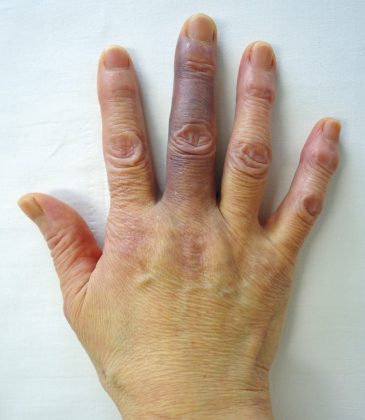- Home
- Editorial
- News
- Practice Guidelines
- Anesthesiology Guidelines
- Cancer Guidelines
- Cardiac Sciences Guidelines
- Critical Care Guidelines
- Dentistry Guidelines
- Dermatology Guidelines
- Diabetes and Endo Guidelines
- Diagnostics Guidelines
- ENT Guidelines
- Featured Practice Guidelines
- Gastroenterology Guidelines
- Geriatrics Guidelines
- Medicine Guidelines
- Nephrology Guidelines
- Neurosciences Guidelines
- Obs and Gynae Guidelines
- Ophthalmology Guidelines
- Orthopaedics Guidelines
- Paediatrics Guidelines
- Psychiatry Guidelines
- Pulmonology Guidelines
- Radiology Guidelines
- Surgery Guidelines
- Urology Guidelines
A rare case of Achenbach’s Syndrome

A Case of Achenbach’s Syndrome reported by Yu Yamamoto at Jichi Medical University School of Medicine, Shimotsuke, Japan and colleagues which have appeared in NEJM.
Achenbach's syndrome is also referred to as “paroxysmal hand hematoma” or “finger apoplexia and is a rare, self-limiting condition, which causes paroxysmal bruising in the hand or fingers. Its aetiology is still unknown. The acute phase can be very alarming and could suggest a more serious vascular disease. Lesions most commonly involve middle and index finger. Episodes may occur spontaneously or after trivial trauma.
 Courtesy NEJM
Courtesy NEJMAccording to the history of the present case, a previously healthy 66-year-old woman presented to the hospital with a sudden-onset pain and bruising in her right middle finger. She reported having a similar episode 3 weeks earlier, which had resolved spontaneously within a few days.
She did not take any regular medication and reported that she had not had any recent trauma. A physical examination revealed subcutaneous hematoma and swelling with normal capillary refill and sensation. The skin color of the fingers did not change in response to exposure to cold. Laboratory tests revealed a normal platelet count and no coagulopathy.
A clinical diagnosis of Achenbach’s syndrome was made. It is a self-limiting condition and patients may seek medical care out of fear because of the sudden pain and bleeding; therefore, diagnosing this condition may relieve anxiety. The patient’s signs and symptoms resolved spontaneously within 1 week without treatment.
The exact etiology of this syndrome is still a mystery. Subcutaneous bruising has been offered as a mechanism in one report. Another recent report suggests that significantly reduced digital blood flow, as seen on arteriography, may be a cause.
Reference,
https://www.nejm.org/doi/full/10.1056/NEJMicm1610146

Disclaimer: This site is primarily intended for healthcare professionals. Any content/information on this website does not replace the advice of medical and/or health professionals and should not be construed as medical/diagnostic advice/endorsement or prescription. Use of this site is subject to our terms of use, privacy policy, advertisement policy. © 2020 Minerva Medical Treatment Pvt Ltd